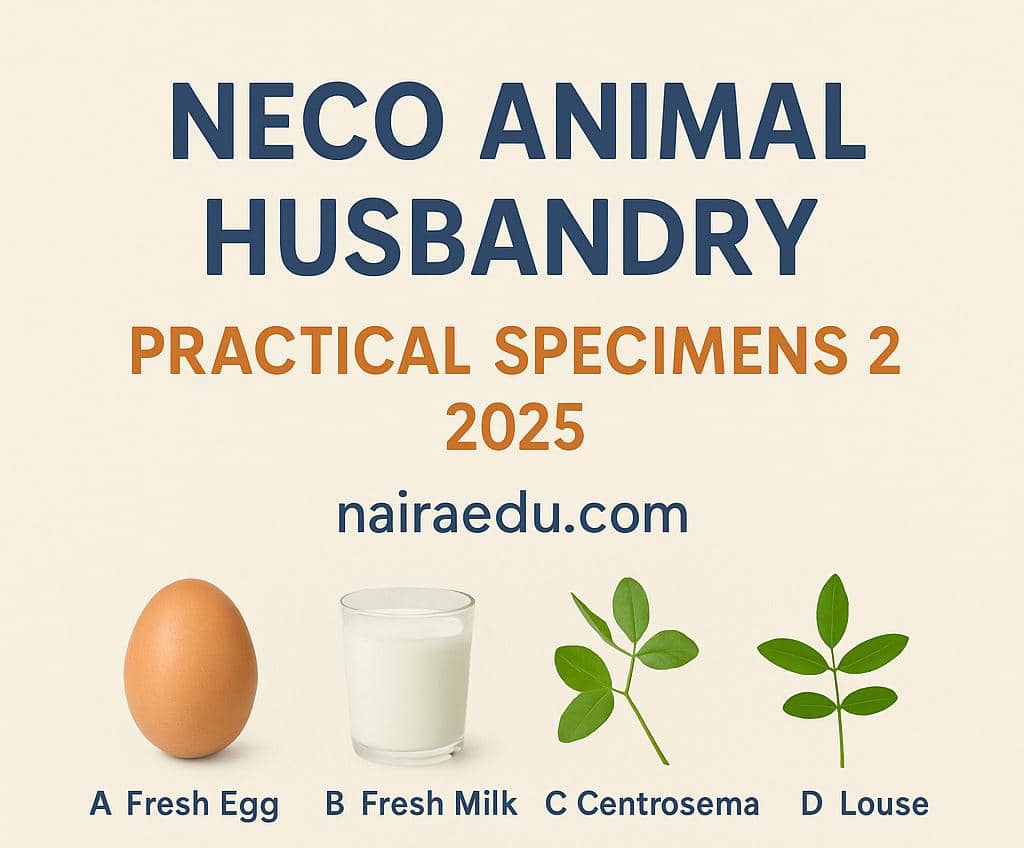NECO Animal Husbandry Practical Specimens 2025 is a very important part of the NECO exam for students offering Agricultural Science. This part of the exam tests your knowledge and understanding of real-life items used in raising animals like poultry, fish, goats, and cows.
For the 2025 NECO exam, the list of official specimens has been released. It includes common items like fresh egg, milk, live fowl, animal feeds, and even tools like the drinker. It also includes forage plants and parasites that affect livestock.
As a teacher, I always tell my students that the best way to pass this practical is to know what each specimen is, what it is used for, and why it is important in animal production. In this post, you will see the full specimen list, detailed explanations, likely exam questions, and helpful tips to prepare and score well.
Full List of NECO Animal Husbandry Practical Specimens 2025
The National Examination Council (NECO) has officially released the Animal Husbandry Practical specimens for the 2025 exam. These specimens are items that students will be asked to identify, describe, or explain during the practical exam.
Below is the full list of the specimens labeled from A to J. As a student preparing for the exam, you are expected to study them and understand their roles in animal production.
| Specimen | Name |
|---|---|
| A | Fresh Egg |
| B | Fresh Milk |
| C | Centrosema |
| D | Bahama Grass |
| E | Animal Bone |
| F | Fresh Fish |
| G | Wood Shavings |
| H | Drinker |
| I | Louse |
| J | Live Fowl |
Note for Students: Try to observe these specimens in real life or study clear pictures of them. It will help you answer faster and better during the practical exam.
Explanation and Uses of Each Specimen
Specimen A – Fresh Egg
A fresh egg is a common product from poultry. It is rich in protein and widely consumed. In animal husbandry, eggs are used to check the productivity of layers. Fresh eggs should be clean, have a firm shell, and no bad smell. In the exam, students may be asked how to identify fresh vs. spoiled eggs.
Specimen B – Fresh Milk
Fresh milk is the liquid food produced by female mammals like cows and goats. It contains proteins, fats, and calcium. In farming, it is used for feeding humans and young animals. Students should know how to identify fresh milk and its importance in dairy farming.
Specimen C – Centrosema
Centrosema is a leguminous pasture plant used to feed animals like goats, sheep, and cattle. It is high in protein and helps animals grow well. Farmers plant centrosema to enrich animal diets, especially during the dry season.
Specimen D – Bahama Grass
Bahama grass is a type of grass used as forage. It is not as rich in protein as centrosema but is good for feeding animals in large quantities. It grows well in Nigeria and is easy to manage, especially in grazing systems.
Specimen E – Animal Bone
Animal bone is part of the skeletal system. It supports the body and protects internal organs. In Animal Husbandry, bones can also be used to identify the species or age of an animal. Crushed bones are sometimes added to animal feed as a source of calcium.
Specimen F – Fresh Fish
Fresh fish is a source of animal protein from aquaculture. In animal production, fish farming (aquaculture) is important for food and income. Students should be able to describe the appearance of a fresh fish (clear eyes, shiny body, and no bad smell).
Specimen G – Wood Shavings
Wood shavings are used as bedding material in poultry houses. They help absorb moisture, keep the pen dry, and reduce smell. Good bedding reduces stress and disease in birds. Students should know how to describe wood shavings and their role in poultry hygiene.
Specimen H – Drinker
A drinker is a container used to give water to animals, especially birds. It is an important equipment in animal pens. Water is vital for animal health, and clean drinkers prevent the spread of diseases.
Specimen I – Louse
Louse is a small parasite that lives on animals and sucks blood or feeds on skin. It causes irritation, poor growth, and can transmit diseases. Farmers control lice using insecticides or good hygiene practices.
Specimen J – Live Fowl
Live fowl refers to a living chicken. It can be a layer, broiler, or local breed. Students should be able to describe features of healthy birds such as bright eyes, active movement, and good feathers. The live fowl is central to poultry farming.
Tip: For the practical exam, you may be asked to identify, describe, or state the function of any of these specimens. Study them carefully.
NECO Animal Husbandry Practical Possible Questions And Answers
Here are common types of questions NECO may ask in the 2025 Animal Husbandry Practical exam. These questions will test your ability to identify specimens and explain their importance in animal production.
Number 1. Specimen A – Fresh Egg
- Identify Specimen A.
- State two ways of checking if an egg is fresh.
- Mention one use of eggs in poultry farming.
Number 2. Specimen B – Fresh Milk
- What is Specimen B?
- List two characteristics of fresh milk.
- Mention one animal that produces it.
Number 3. Specimens C and D – Centrosema and Bahama Grass
- Name Specimens C and D.
- State two differences between them.
- Which is more suitable as protein-rich animal feed?
Number 4. Specimen I – Louse
- Identify the specimen.
- Mention one way it affects animals.
- Suggest one method of control.
Number 5. Specimen E – Animal Bone
- Name the specimen.
- State two functions of bones in animals.
- What mineral can be obtained from bones?
Number 6. Specimen G – Wood Shavings
- Identify the specimen.
- State two uses of wood shavings in poultry housing.
- Mention one alternative material used as bedding.
Number 7. Specimen H – Drinker
- What is Specimen H?
- State one function of a drinker.
- Why is clean water important for poultry?
Number 8. Specimen F – Fresh Fish
- Identify Specimen F.
- List two signs that fish is fresh.
- State one importance of fish in human diet.
Number 9. Specimen J – Live Fowl
- Name the specimen.
- Mention two physical features of a healthy fowl.
- State one sign that shows a fowl is sick.
Reminder: Always answer with clear and simple English. If a diagram is asked for, draw neatly with a pencil and label properly.
RELATED POST:
NECO Agricultural Science Practical Specimens 2025
NECO Marketing 2025 Questions And Answers Expo
2025 NECO Marketing 2025 Questions And Answers Expo
NECO Data Processing Practical Questions And Answers 2025
Conclusion
The NECO Animal Husbandry Practical exam may look difficult at first, but once you understand the specimens and how they are used in animal farming, everything becomes easier.
In this post, we have shown you the full list of NECO Animal Husbandry Practical Specimens for 2025, explained each one in simple terms, gave you likely exam questions, tips to prepare, and answered common FAQs. If you follow everything shared here, you are already ahead of many others.
Always remember: the key to passing NECO practical is not cramming, but understanding and observation. Try to see the specimens in real life, revise with friends, and practice answering past questions.
If this post helped you, please share it with your classmates or school WhatsApp group. You can also save this page or comment below if you need further help.

Mr. Femi is an education blogger who simplifies exam updates and study tips for Nigerian students. His goal is to make learning smart, easy, and rewarding.


3 thoughts on “NECO Animal Husbandry Practical Specimens 2025”